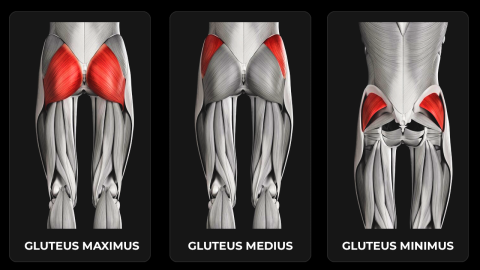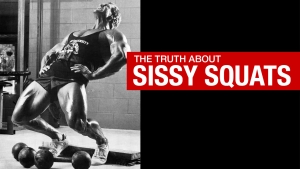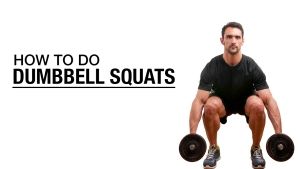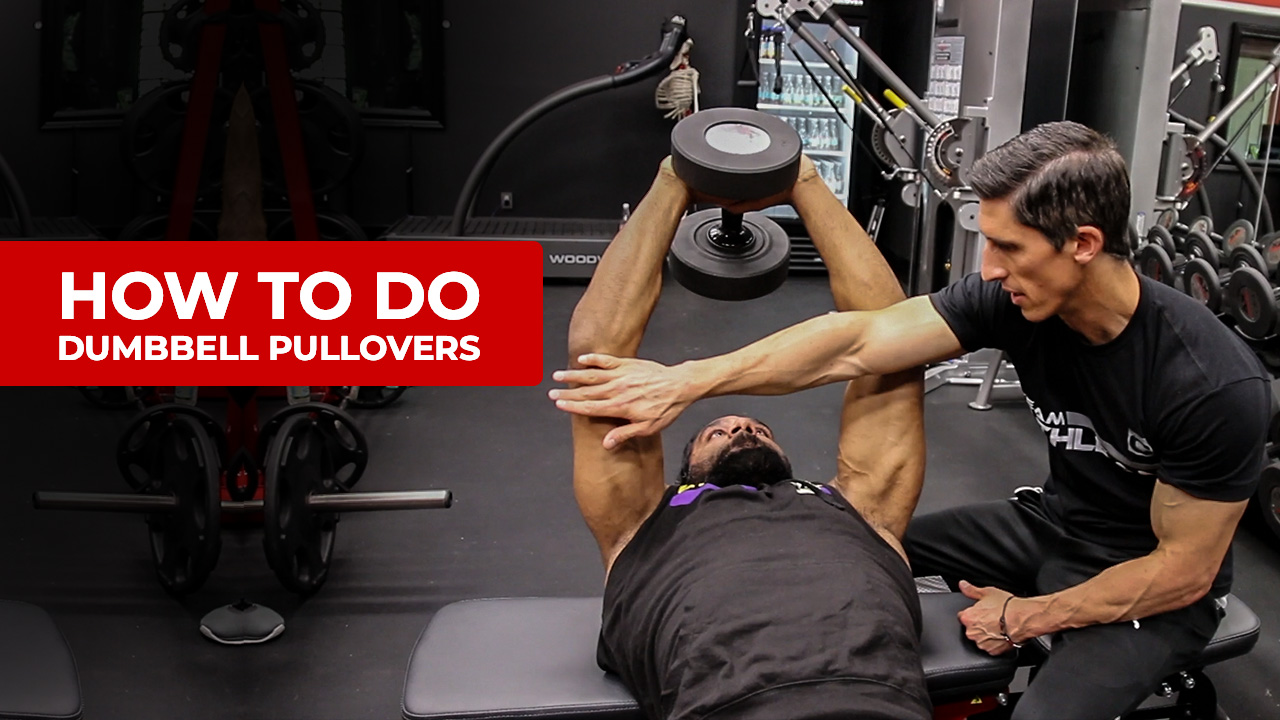
HOW TO DO THE GLUTE HAM RAISE
In the world of lower body workouts, there’s a sea of exercises claiming to target your glutes and hamstrings.
But not all of them are worth your time.
However, there is one exercise that delivers – I’m talking about the Glute Ham Raise.
This isn’t just any exercise. One of the common benefits of this exercise is that it synergizes the function of your glutes and hamstrings, giving you that coveted two-for-one efficiency.
It’s also an excellent deadlift assistance exercise.
But here’s the deal – while the Glute Ham Raise is unmatched in sculpting powerful hamstrings and glutes, mastering it isn’t a walk in the park for every weightlifter.
That’s about to change.
We’re diving deep today, breaking down the biomechanics behind this explosive exercise, and I’m going to walk you through the proper technique step by step.
Plus, I’ll throw in a few Glute Ham Raise variations you can try right in your living room.
Get ready to elevate your lower body workout routine with Glute Ham Raise exercises. We’re not just working out; we’re building smarter, stronger bodies.
GLUTE HAM RAISE MUSCLES ACTIVATED
As always, I want to start with a breakdown of the muscles that are targeted during this glute ham developer.
I can’t stress this enough, guys – Building a mind-to-muscle connection will help you perform the exercise better, ensuring the results you’re looking for.
When you just move through an exercise with no real thought behind it, you’re only cheating yourself out of muscle activation and potential gains.
Here are the primary muscle groups that are targeted during a Glute Ham Raise:
BICEPS FEMORIS

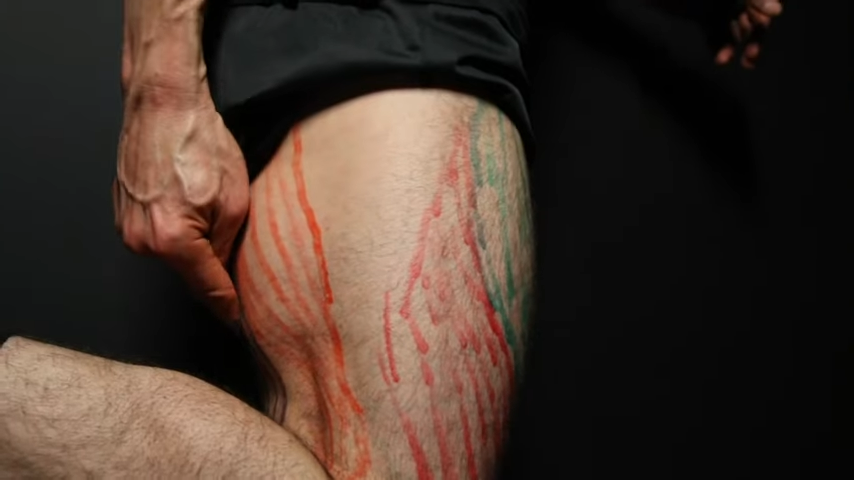
The biceps femoris is one of the Glute Ham Raise muscles in the back of your thigh or the hamstrings.
It’s made up of two sections: one that starts from a bony part of your pelvis near your sitting bone and another that begins from your thigh bone.
This muscle stretches down the back of your thigh and attaches near your knee, on a smaller bone called the fibula.
The primary functions of the biceps femoris include:
- Knee Flexion: It is crucial for bending the knee, enabling movements like walking, running, and squatting.
- Hip Extension: The long head of the biceps femoris assists in extending the hip, an essential action in many activities, including jumping and starting a sprint.
- Lateral Rotation: Both heads of the biceps femoris contribute to the outward (lateral) rotation of the lower leg when the knee is bent.
SEMITENDINOSUS

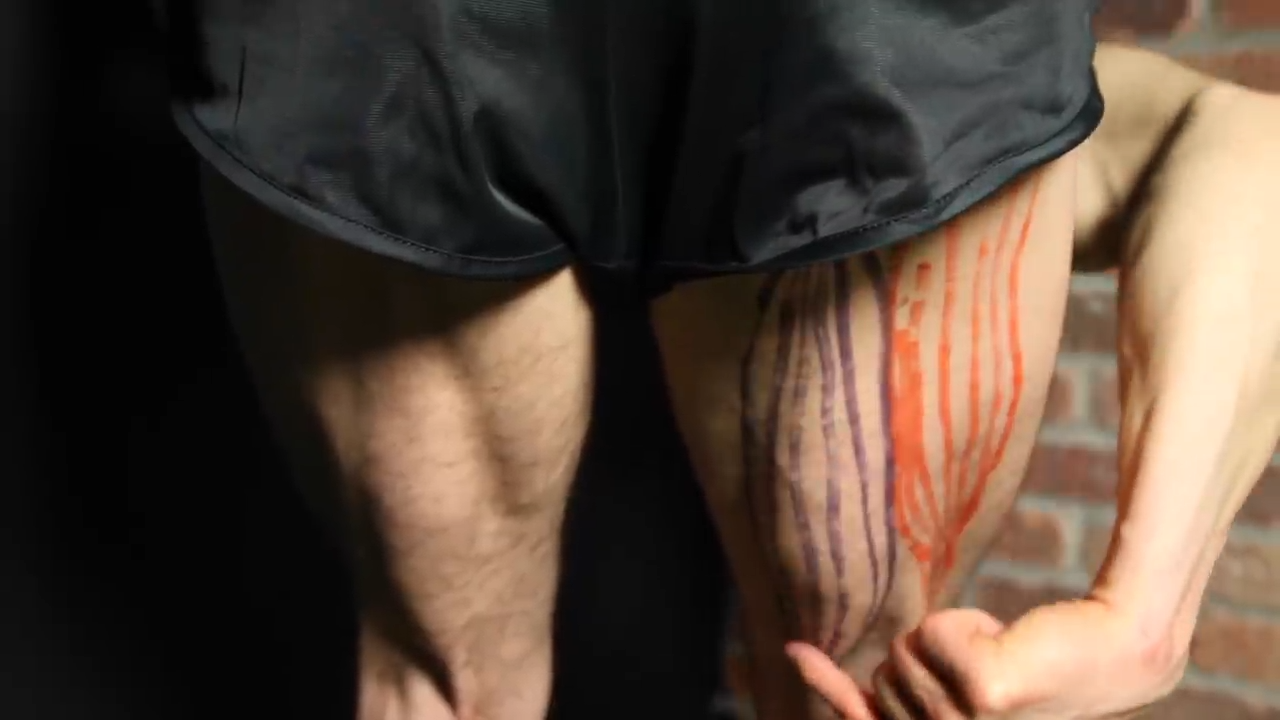
The semitendinosus is a muscle that starts from a bony point in your pelvis, right where you sit, much like the biceps femoris.
It stretches down to attach to the inner side of your shin bone, just below your knee.
This muscle runs along the inner part of your thigh and is known for having a long, cord-like ending where it attaches, which is where it gets its name.
The functions of the semitendinosus include:
- Knee Flexion: It plays a critical role in bending the knee, a fundamental movement in daily activities and sports.
- Hip Extension: The semitendinosus assists in extending the hip, contributing to movements like walking, running, and jumping.
- Medial Rotation: When the knee is flexed, the semitendinosus helps in medially rotating the lower leg, which means turning it inward toward the body’s midline.
GLUTEUS MAXIMUS
The gluteus maximus is the biggest muscle in your buttocks, sitting right at the top and making up most of its shape and size.
This muscle starts from the back part of your hip bone, tailbone, and the very bottom of your spine.
It stretches down to connect to the side of your thigh bone and a thick band of tissue running down the side of your leg.
It’s a strong and wide muscle that gives your backside its rounded appearance.
The primary functions of the gluteus maximus include:
- Hip Extension: It is the main muscle responsible for extending the hip, an action crucial for movements such as standing up from a seated position, climbing stairs, and running.
- Lateral Rotation: The gluteus maximus also assists in the lateral (outward) rotation of the thigh, which is important for stabilizing the hip during activities like walking and running.
- Posterior Pelvic Tilt: It plays a role in tilting the pelvis backward, which can help maintain proper posture and reduce strain on the lower back.
The Glute-Ham Raise is one of my favorite hamstring exercises and glute exercises.
GLUTEUS MEDIUS
The gluteus medius is located on the outside of the upper buttock, just beneath the gluteus maximus.
It starts from the side part of your hip bone, kind of in the middle of where your hip sticks out, and it stretches down to attach to the top part of your thigh bone, on the side.
The gluteus medius is primarily involved in:
- Abduction of the Hip: It is essential for moving the thigh away from the body’s midline, which is crucial for actions such as walking, running, and side-stepping.
- Medial and Lateral Rotation: Depending on the position of the hip and knee, the gluteus medius can assist in both medial (inward) and lateral (outward) rotation of the thigh.
- Pelvic Stabilization: It plays a key role in stabilizing the pelvis on the femur during single-leg activities, such as when walking or running, which helps maintain balance and proper gait.
GLUTEUS MINIMUS
The gluteus minimus might be the tiniest of the trio of butt muscles, tucked away under the gluteus medius on the side of your hip.
But don’t let its small size fool you; this muscle is important when it comes to keeping your hips stable and helping you move smoothly.
It originates from the outer surface of the ilium, which is part of the hip bone, and inserts into the greater trochanter of the femur, the large bony knob on the side of your thigh bone.
The primary functions of the gluteus minimus include:
- Abduction of the Hip: It helps to move the thigh away from the body’s midline, similar to stepping to the side.
- Medial Rotation: When the hip is flexed, the gluteus minimus can rotate the thigh inward.
- Stabilizing the Pelvis: Especially important during activities like walking or running, it helps keep the pelvis level and stable, preventing it from dropping to the opposite side.
BENEFITS OF THE GLUTE HAM RAISE
The Glute-Ham Raise stands out as a pinnacle exercise within strength training regimens, especially for those aiming to enhance their lower body power and resilience.
This multifaceted exercise not only targets the hamstrings but also engages a wide array of muscle groups, offering a comprehensive workout that transcends the benefits of many traditional exercises like the Stiff-Leg Deadlift.
COMPREHENSIVE POSTERIOR CHAIN DEVELOPMENT
Unlike isolated exercises, the Glute-Ham Raise is a closed-chain movement that recruits the entire posterior chain, including the hamstrings, glutes, calves, and lower back muscles.
This holistic engagement is crucial for building balanced muscle strength and symmetry, reducing the risk of common injuries associated with weaker muscle groups.
ENHANCED HAMSTRING STRENGTH AND HYPERTROPHY
Renowned as one of the favorite hamstring exercises among athletes and fitness enthusiasts, the Glute-Ham Raise is an excellent hypertrophy exercise.
It uniquely stresses the hamstrings through both knee flexion and hip extension, a combination seldom found in other exercises, making it an effective option for building significant hamstring strength and muscle mass.
IMPROVED CORE STABILITY
The Glute-Ham Raise transcends traditional leg exercises by incorporating significant core engagement.
Maintaining stability throughout the movement requires sustained contraction of the abdominal and lower back muscles, making it an effective core training movement.
This core involvement is critical for full-body strength and stability, benefiting performance in both athletic endeavors and everyday activities.
VERSATILITY AND SCALABILITY
With the use of glute-ham benches, elastic exercise bands, and various body positions, the Glute-Ham Raise offers a wide range of exercise variations and intensities.
From the standard bodyweight Glute-Ham Raise to band-assisted options and modifications that involve holding weights, there’s a version suitable for every fitness level.
This versatility ensures that as your strength improves, you can continue to challenge yourself with heavier weights or more demanding variations.
INJURY PREVENTION AND REHABILITATION
The controlled, eccentric nature of the Glute-Ham Raise makes it an ideal exercise for hamstring injury prevention and rehabilitation.
By strengthening the hamstrings in a comprehensive manner, it can help protect against the muscle strains and tears that are common in high-impact sports and activities.
Additionally, the ability to adjust the intensity and range of motion makes it a safe option for gradually reintegrating strength training following an injury.
REST AND RECOVERY OPTIMIZATION
Incorporating appropriate rest periods, such as 45-60 seconds for endurance-focused workouts or 90-120 seconds for strength-focused sessions, is crucial in maximizing the benefits of the Glute-Ham Raise.
These rest intervals allow for adequate muscle recovery, ensuring that each set is performed with optimal effort and form.
SUPPORTS COMPOUND MOVEMENTS
The strength and stability gained from regular Glute-Ham Raises have direct carryover to compound movements such as heavy Back Squats and Single-Leg Squats.
By improving hamstring strength and core stability, athletes can expect to see improvements in their performance in these and other foundational exercises, contributing to overall athletic prowess.
HOW TO DO A GLUTE HAM RAISE
Now that you know which muscles to focus on, let’s get to work on learning how to do the Glute-Ham Raise movement with correct form.
In order to do this, you’ll need a Glute Ham Raise machine.
Don’t worry if you don’t have access to this piece of equipment since I’m going to show a Glute Ham Raise alternative below.
GLUTE HAM RAISE

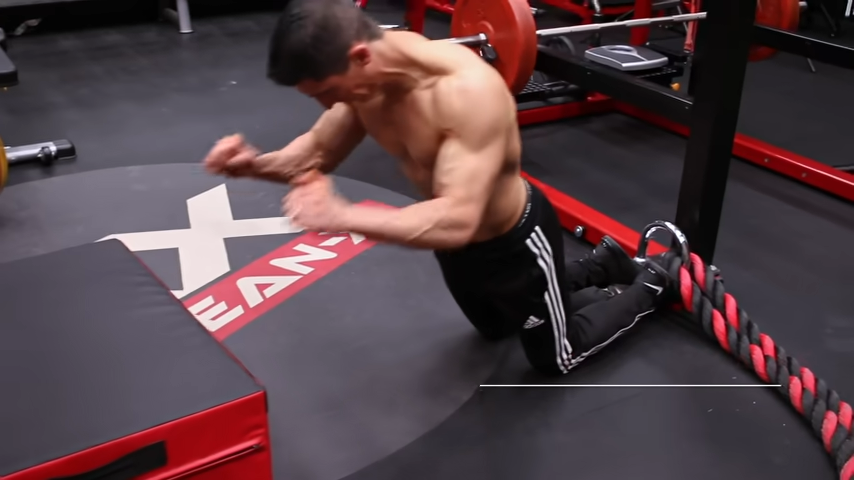
HOW TO DO THE GLUTE HAM RAISE:
- Before starting, ensure the GHR machine is adjusted to fit your body. The foot plate should be positioned so that when you’re in the machine, your knees are just behind the pad, and your feet are securely anchored.
- Climb onto the machine, placing your thighs on the pads and securing your feet under the foot plate. Your knees should be just behind the pad, and your body should form a straight line from your knees to your head.
- Start with your body in a horizontal position, parallel to the floor. Your torso should be straight, and your spine should be in a neutral position. Place your hands across your chest or behind your head, depending on your comfort and balance.
- Begin by slowly lowering your upper body towards the floor, keeping your back straight and your core engaged. Lower yourself as far as you can while maintaining control and without letting your hips sag.
- Using your hamstrings and glutes, raise your torso back to the starting position. It’s crucial to focus on using your hamstrings and glutes to pull yourself up rather than relying on momentum.
- Ensure that your movements are controlled and deliberate throughout this difficult exercise. Avoid jerky motions or using your arms to assist in the raise. Keep your hips extended, so your body remains in a straight line from knees to shoulders.
- Exhale as you raise your body and inhale as you lower it. Proper breathing helps maintain stability and provides the strength needed for the lift.
WHAT MAKES IT EFFECTIVE: On the Glute Ham Raise, you get that initial contraction from the glutes to stabilize the pelvis and assist in the driving of the whole body up into this knee flexion position. This is a tremendous overload on the hamstrings. And you can actually increase the load here by simply adding an additional weight plate or wearing a weighted vest.
GLUTE-HAM RAISE COMMON MISTAKES
A cornerstone in posterior-chain exercises, the Glute-Ham Raise offers numerous direct benefits for fitness athletes aiming to increase hamstring strength, build muscle mass, and enhance overall functional strength.
However, despite its effectiveness, common mistakes often undermine its potential, leading to suboptimal gains or even injury.
Understanding the biggest mistakes is crucial for athletes, coaches, and fitness enthusiasts to maximize the exercise’s utility as an excellent hypertrophy and strength-building movement.
INCORRECT FOOT PLACEMENT
One of the first errors involves improper foot placement on the foot platform or within the adjustable ankle pads.
The feet should be positioned flat, providing stable support, and enabling effective force transfer throughout the movement.
Incorrect placement can compromise the exercise’s efficiency, detracting from its role as a closed-chain exercise and limiting its function as a complete hamstring movement.
NEGLECTING CORE ENGAGEMENT
A weak core significantly hampers the ability to perform the glute-ham raise correctly.
The core must remain engaged to maintain a neutral spine position throughout the movement, ensuring a fluid and controlled execution.
A lack of core stability can lead to an arched back, shifting the focus away from the hamstrings and glutes, and potentially leading to lower back strain.
MISALIGNING THE HIP AND SHOULDER POSITION
Proper alignment is crucial, with the hip position needing to be in sync with the shoulder blades, especially in the extended position at the top of the movement.
Misalignment can disrupt the exercise’s biomechanics, reducing its effectiveness as a posterior chain and core training movement.
Athletes should strive for a straight line from their shoulders to their knees at the apex of the movement.
OVERLOADING TOO SOON
While the Glute-Ham Raise is an effective bodyweight exercise, adding loads through external loading like barbells or bands should be approached with caution.
Starting with heavier loads before mastering the correct form and building up sufficient base strength can lead to compromised form and increased risk of injury.
Athletes should focus on mastering the bodyweight version before gradually introducing lighter weights and progressing to heavier weights as strength levels improve.
IGNORING ECCENTRIC MUSCLE CONTRACTIONS
The downward or eccentric phase of the Glute-Ham Raise is where much of the hamstring and glute strengthening occurs.
Rushing through this phase or not controlling the downward movement diminishes the exercise’s effectiveness in building hamstring strength and muscle mass.
Athletes should focus on maintaining a controlled, fluid movement throughout the eccentric phase to maximize muscle engagement.
INCORRECT BENCH ANGLE ADJUSTMENT
The angle of the glute ham bench or adjustable utility bench plays a significant role in determining the exercise’s difficulty level.
Setting the bench at an inappropriate angle for one’s strength level—either too steep or too shallow—can either excessively increase the difficulty, leading to bad form, or reduce the exercise’s effectiveness.
It’s crucial to adjust the bench to an angle that challenges the athlete while still allowing for the correct form.
OVERLOOKING THE IMPORTANCE OF ACCESSORY MOVEMENTS
The Glute-Ham Raise should not be performed in isolation but rather integrated into a broader training regimen that includes accessory movements like band-assisted Nordic curls, Hamstring Curls, and other compound movements.
These exercises complement the Glute-Ham Raise by targeting similar muscle groups from different angles and contributing to a more comprehensive strength and hypertrophy program.
By addressing these common mistakes, athletes and fitness enthusiasts can harness the full potential of the Glute-Ham Raise.
This will make it a must-have exercise for developing strong glutes, hamstrings, and a powerful posterior chain, essential for both everyday functional strength and high-level athletic performance.
GLUTE HAM RAISE VARIATIONS
But let’s say you don’t have access to the Glute-Ham Raise exercise machine.
Well, you have a couple of options.
Both of these are bodyweight exercises, and both are fantastic exercises.
They are eccentric-focused exercises targeting weak glutes and hamstrings.
Best of all, you can do these alternative exercises in the comfort of your home.
STABILITY BALL GLUTE HAM RAISE


HOW TO DO THE STABILITY BALL GLUTE HAM RAISE:
- Kneel on the floor and secure your feet under the anchor point. The tops of your feet should be flat against the floor.
- Position the stability ball in front of you, within arm’s reach. Lean forward and place your forearms on the ball, hands clasped together for stability.
- With your forearms on the ball, roll the ball forward by extending your arms and leaning forward. Your body should straighten out, and you should feel your hamstrings stretching as you move into a plank-like position with your weight on the ball.
- To return to the starting position, engage your hamstrings and glutes to pull your body back up. Use your legs to drive the movement, pulling the ball back towards your knees as you return to the kneeling position.
WHAT MAKES IT EFFECTIVE: This body compound exercise involves both the lengthening (eccentric phase) and shortening (concentric phase) of the hamstring and gluteal muscles. The eccentric phase is known for its effectiveness in muscle building and strength gains due to the increased tension it places on the muscle fibers.
SLICK FLOOR BRIDGE CURL

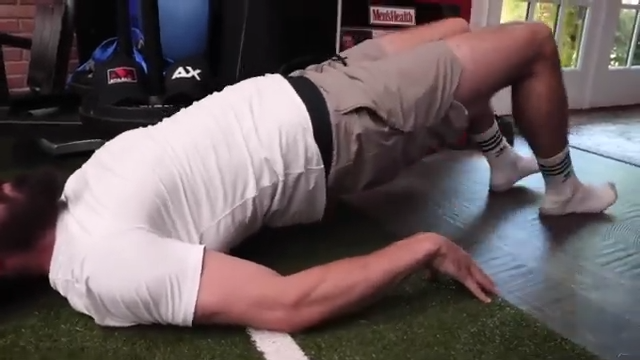
HOW TO DO THE SLICK FLOOR BRIDGE CURL:
- Find a smooth, slick surface in your home where you can lie down, such as a hardwood or tiled floor. Carpeted surfaces won’t work well for this compound exercise because your feet need to slide easily.
- Put on a pair of socks to reduce friction and allow your feet to slide smoothly on the floor. Make sure they’re secure and won’t come off during the exercise.
- Start by lying on your back, bending your knees so your feet are flat on the ground and spread hip-width apart. Place your arms down by your sides, palms facing down, to keep yourself stable.
- Engage your core and glutes to lift your hips off the floor, forming a straight line from your shoulders to your knees. This is your starting bridge position.
- While keeping your hips elevated, slowly slide your feet away from your body, straightening your legs as much as possible without dropping your hips. The motion should be controlled and smooth, relying on your hamstrings’ strength to move your feet.
- Engage your hamstrings and glutes to slide your feet back toward your body, returning to the bridge position with your knees bent. Maintain the elevation of your hips throughout the movement.
WHAT MAKES IT EFFECTIVE: This bodyweight exercise is deceptively challenging, offering significant eccentric overload. The crucial aspect is to maintain your glutes elevated as you slide your feet. For an extra challenge, attempt it one leg at a time—it’s tough but effective. This method activates both key muscle groups simultaneously, achieving that ideal synergy.
The Glute Ham Raise stands out as a dynamic exercise for enhancing lower body strength by activating the hamstrings and glutes in unison.
Whether performed on a machine or adapted with home equipment like a stability ball, it promises significant muscles gains, strength, and functional performance.
No matter what your training goals are, you need to add this into your lower body exercise program.
If you’re looking for a training program to get you strong and ripped from head to toe, be sure to try our Program Selector and grab the ATHLEAN-X program that best matches your current training goals. We’ve got something for everyone… from beginners to experienced lifters.

- Looking for an effective exercise for your posterior chain muscles? The Glute Ham Raise activates both the hamstrings and glutes simultaneously.
- It can be performed on a Glute Ham Raise machine, but if you don’t have access to this machine, you can perform body weight options such as a Stability Ball Glute Ham Raise or a Slick Floor Bridge.
- To perform a Glute Ham Raise with proper form, make sure to adjust the GHR machine so your knees are just behind the pad and your feet are firmly in place.
- Get on the machine, positioning your thighs on the pads to create a straight line from your knees up to your head.
- Begin with your body level, keeping your torso aligned, and use your hands for stability either across your chest or behind your head.
- Gently lower your upper body to the floor, ensuring your back remains straight and your core tight, avoiding any droop in your hips.
- Engage your hamstrings and glutes to return your torso to its starting position, prioritizing muscle use over momentum.
- Keep your movements fluid and precise, with your hips extended to maintain correct posture. Sync your breathing with the exercise, exhaling as you lift and inhaling on the descent, to boost both stability and power.
GLUTE HAM RAISE FAQS
Before starting on the Glute Ham Raise machine, adjust it so that your knees are slightly behind the pad and your ankles are securely anchored in the ankle roller pads.
Position yourself on the machine with your thighs on the pads, maintaining a straight line from your knees to your head.
Start in a horizontal position with your torso straight, placing your hands for balance either across your chest or behind your head.
Lower your upper body slowly towards the floor, keeping your back straight and core engaged, without letting your hips sag.
Use your hamstrings and glutes to follow the range of motion and lift your torso back to the upright position, focusing on muscle engagement rather than momentum.
Ensure your movements are smooth and controlled, maintaining extended hips for proper alignment. If you feel knee pain, stop the movement immediately to decrease your risk of injury.
Coordinate your breathing with your movements, exhaling as you lift and inhaling as you lower, to enhance stability and strength during the exercise. Rest for a moment and begin again.
The Glute Ham Raise is an excellent exercise for strengthening the posterior muscles, which includes the glutes, hamstrings, lower back, and even the calf muscles to some extent.
Its primary benefit lies in its ability to intensively target and develop the hamstrings, enhancing both their strength and endurance. This is important not only for athletic performance, where strong hamstrings contribute to speed, power, and agility, but also for everyday activities that involve bending, walking, or climbing.
Additionally, by engaging the glutes, the exercise helps in improving hip extension, which is essential for explosive athletic movements and can aid in injury prevention by stabilizing the pelvis and lower back.
The Glute Ham Raise also indirectly supports core strength and posture due to the stabilization required during the exercise.
It’s an excellent exercise to add into any lower body routine.
The Glute Ham Raise and Romanian Deadlifts (RDL) are both effective hamstring exercises for targeting the backside muscles, but they differ significantly in execution and emphasis.
The Glute Ham Raise is performed on a specific machine or with alternative equipment like a stability ball, focusing intensely on the hamstrings and glutes.
In this exercise, you fix your feet in place and use your hamstrings to lift your torso against gravity, engaging the lower back and glutes as secondary muscles.
On the other hand, the RDL is a form of deadlift where you hold a barbell or dumbbells and hinge at the hip joints, keeping your legs relatively straight.
The movement pattern involves lowering the weights towards the ground and then lifting them by extending the hips, heavily engaging the hamstrings, glutes, and lower back, with a significant emphasis on the erector spinae of the lower back.
While both exercises strengthen the back of the body, the Glute Ham Raise focuses more on hamstring curling action, and the RDL emphasizes hip hinging and is more comprehensive in targeting the entire posterior chain, including a more pronounced engagement of the lower back.
The Glute Ham Raise and the Hamstring Curl are both popular exercises for targeting the hamstrings, but they differ in terms of equipment, execution, and muscle engagement.
The Glute Ham Raise is typically performed on a specialized machine that supports the body from the thighs or hips, allowing the legs to move freely.
The exercise involves a compound movement where you stabilize your body using your hamstrings and glutes to lift your torso against gravity. This exercise not only targets the hamstrings but also engages the glutes, lower back, and core, making it a more holistic posterior chain strength workout.
On the other hand, the Hamstring Curl (Nordic Curl) is usually done as a machine leg curl, where you lie face down or sit, and curl weights towards your buttocks by bending your knees.
This movement isolates the hamstrings more directly, with less involvement from other muscle groups.
Hamstring Curls focuses on the concentric contraction of the hamstring muscles, making it an excellent exercise for specifically targeting and strengthening these muscles.

Jeff Cavaliere M.S.P.T, CSCS
Jeff Cavaliere is a Physical Therapist, Strength Coach and creator of the ATHLEAN-X Training Programs and ATHLEAN-Rx Supplements. He has a Masters in Physical Therapy (MSPT) and has worked as Head Physical Therapist for the New York Mets, as well as training many elite professional athletes in Major League Baseball, NFL, MMA and professional wrestling. His programs produce “next level” achievements in muscle size, strength and performance for professional athletes and anyone looking to build a muscular athletic physique.
















